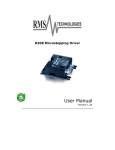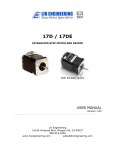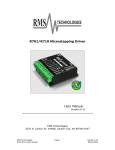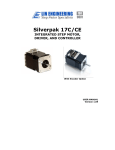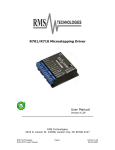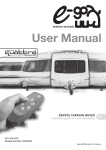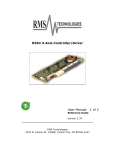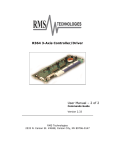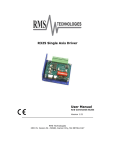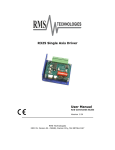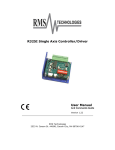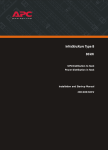Download Driver
Transcript
R208 Microstepping Driver User Manual Version 1.22 RMS Technologies 2533 N. Carson St. #4698, Carson City, NV 89706-0147 Thank you for purchasing the R208 driver. This product is warranted to be free of manufacturing defects for one year from the date of purchase. Technical Support for Lin Enigneering, a distributor for RMS Technologies By Telephone: 408-919-0200 (Mon.-Fri., 8:00 a.m.-5:00 p.m.) On the Web: www.linengineering.com Our technical support group is glad to work with you in answering your questions. If you cannot find the solution to your particular application, or, if for any reason you need additional technical assistance, please call technical support at 408-919-0200. PLEASE READ BEFORE USING Before you start, ensure that there is a suitable DC power supply and step motor. In addition, a suitable STEP and DIRECTION pulse source is also required. DISCLAIMER The information provided in this document is believed to be reliable. However, no responsibility is assumed for any possible inaccuracies or omissions. Specifications are subject to change without notice. RMS Technologies reserves the right to make changes without further notice to any products herein to improve reliability, function, or design. RMS Technologies does not assume any liability arising out of the application or use of any product or circuit described herein; neither does it convey any license under its patent rights, nor the rights of others. CHANGES TO THE R208 DRIVER BOARD Prior to OCTOBER 1, 2005 the R208 driver board used slower opto-couplers, limiting the step pulse timing. The old driver board also read step pulses on the rising edge. A revision change was made on October 1, 2005, using more advanced opto-couplers. These new opto-couplers can read faster data, yet they are also more sensitive to older PLC step pulses. If your step pulse signal is not clear, the R208 will pick this up and the motor will rotate “rough” and irratic. The new boards read step pulses on the falling edge. If the falling edge of your step pulse is not a clear signal, the motor will rotate “rough” and irratic. So far, only a small handful of customers have been affected by the change. Mostly those that use PLC’s from the early 90’s and older. Customers can still request the old R208 boards in quantities of 100 per order (blanket releases are OK). The old boards are under part number: R208-05. New RoHS style boards: All boards sold after September 31, 2007 are RoHS compliant. In addition to the RoHS change, the R208 has new features: to be able to change holding current from 23% or 100% of the run current, and to change which step pulse edge to read the pulses from: rising edge or falling edge. Special Symbols Indicates a WARNING and that this information could prevent injury, loss of property, or even death (in extreme cases). RMS Technologies R208 Microstepping Driver Manual Page 2 Version 1.22 8/31/2007 R208 User Manual Product: Version: Date: R208 1.22 8/31/2007 Version History Version Date 1.16 02/02/2005 1.17 10/17/2005 1.18 11/09/2006 Updated equation for Voltage Reference. Typographical Errors 1.19 2/2/2007 Standardization of User Manuals 1.20 6/7/2007 1.21 8/24/2007 1.22 8/31/2007 Added min. order qty for R20805; updated description of opto supply. Updated info on internal resistors and recommended resistors for opto-isolatd inputs Updated RoHS style R208 boards RMS Technologies R208 Microstepping Driver Manual Page 3 Description of Changes Version 1.22 8/31/2007 TABLE OF CONTENTS 1. FEATURES 5 Automatic Current Cutback Feature 5 2. ELECTRICAL SPECIFICATIONS 6 3. OPERATING SPECIFICATIONS 6 Operating Temperature Logic Input Timing 6 6 4. MECHANICAL SPECIFICATIONS 7 Dimensions 7 5. PIN ASSIGNMENTS 8 6. CONNECTION SPECIFICATIONS 8 List of Parts Mating Connectors 8 8 Adjusting the Output Current 9 How to Connect Alternative Step Resolution Connection 7. CONFIGURING AND CONTROLLING THE R208 10 11 12 Signal Control Specifications 12 Internal Schematic 12 Internal Schematic Resistor Values for the Opto Supply 13 13 8. MOTOR CONNECTIONS 14 4 Lead Wire Motor Connection 14 6 Lead Wire Motor Connection 14 8 Lead Wire Motor Connection 15 9. TROUBLESHOOTING & FAQ RMS Technologies R208 Microstepping Driver Manual 16 Page 4 Version 1.22 8/31/2007 1. FEATURES • • • • • • • • • • • • • • • • Bipolar Step Motor Driver Low Cost Small size 2.464” x 1.932” x .848” (62.59 x 49.07 x 21.54 mm) Selectable Step Resolutions of: Full Step, Half Step, 4x, 8x Microsteps Optically Isolated Step, Direction, and Disable/Enable Inputs Selection of holding current to be 23% or 100% of the run current Operates on +12 to +24 VDC Low Power Dissipation Efficient Current Control Thermal Shutdown, Under-voltage Protection Power-on Indicator Power Disable/Enable Control Sinusoidal current waveform Phase Current Range from 0.35 to 2.0 Amp Choice of reading each step input on the rising edge or falling edge of pulse Default Setting is 1.0 Amp RMS or, 1.4 Amp Peak* * The default current can be preset at different values prior to shipping per customer’s request Automatic Current Cutback Feature The R208 unit offers the user the option of using the Current Cutback function in the form of a dip switch. The default setting is set to the Enabled position. This means that when pulse input is discontinued, the driver will produce 23% of the Peak running current. When this switch is set to the Disabled position, the driver will produce 100% of the running current. To change the position of the Current Cutback Switch, simply move the switch towards the “100” mark on the silk screen. This indicates that it is using 100% of the run current. In other words, there is no cutback to the current. RMS Technologies R208 Microstepping Driver Manual Page 5 Version 1.22 8/31/2007 2. ELECTRICAL SPECIFICATIONS Supply Voltage: Peak Current: +12 to 24 VDC 0.35 to 2.0 Amps OR 0.25 to 1.4 Amps/Phase 100% duty cycle is OK as long as bottom of unit is 50°C or less 3. OPERATING SPECIFICATIONS Operating Temperature: -20° to 50° Celsius Humidity Range: 0 to 95% (non-condensing) Logic Input Timing (A) Minimum Command Active Time Before Step Pulse (Data Set-up Time) (B) Minimum Command Active Time After Step Pulse (Data Hold Time) (C) Minimum Step Pulse Width (D) Minimum Step Low Time (E) Maximum Power-Down Recovery Time Maximum Step Frequency 200 nanoseconds 200 nanoseconds 20 microseconds 20 microseconds 20 milliseconds 30 kHz Figure 1: Timing Diagram NOTE: The R208, by default steps on the falling edge into the opto-coupler. RMS Technologies R208 Microstepping Driver Manual Page 6 Version 1.22 8/31/2007 4. MECHANICAL SPECIFICATIONS Size: Weight: Mounting: Cover: Plate/Heatsink: Color: 2.464” x 1.932” x .848” (62.59 mm x 49.07 mm x 21.54 mm) 3.68 oz (104 g) Four screws, 1.622” x 2.003” (41.20 mm x 50.88 mm) Steel Aluminum, Anodized Black Exterior Dimensions Figure 2: R208 Dimensions Diagram RMS Technologies R208 Microstepping Driver Manual Page 7 Version 1.22 8/31/2007 5. PIN ASSIGNMENTS A DB-9 female connector cable receives power and provides the control connections for the R208 Driver. Active signals are optically isolated. An open-collector drive is required to provide pulses for Step, levels for Direction and Disable/Enable. PIN # COLOR FUNCTION DESCRIPTION (#26 AWG Lead) 1 2 Red Black 3 Brown 4 Black/White 5 Orange 6 Green 7 White 8 Blue 9 Yellow +V SR1 Input Motor Supply Voltage. +12 to +24 VDC Step Resolution 1. Pins 2 & 3 are used to preset the step resolution by selective contact to ground (Pin 7) SR2 Input Step Resolution 2. Pins 2 & 3 are used to preset the step resolution by selective contact to ground (Pin 7) Enable/Disable This input is used to enable/disable the Input output of the driver Direction Input This input is used to change the rotation direction of the motor Power Ground The ground or return of power supply connects here. Logic Ground Used to ground to the logic functions (i.e. step resolution) Opto Supply +5 VDC input used to supply power to the (Input) isolated logic inputs** Step Clock Connects to the open-collector drive. Table 1: Pin Assignments WARNING! - Do not apply differential voltage on SR1 and SR2, this will damage the driver. ** The Resistors shall be connected in series with each Input: Pin 4 (Disable), Pin 5 (Direction), and Pin 9 (Step) if you are to use an opto supply of more than +5VDC. See Section 7. 6. CONNECTION SPECIFICATIONS List of Parts Connection of the R208 is simple. Here is what you need: • External Main Power Supply (+12 to +24 VDC) • +5 VDC Power Supply used as the Opto Supply • Voltmeter • Function Generator • An appropriate Bipolar Step Motor • Mating Connector Cables that are provided with the R208 Driver Mating Connectors A mating DB-9 connector and crimp style connector will be provided. Color Function Red A+ Phase Blue A- Phase Green B+ Phase Black B- Phase Table 2: Pinouts for 090-018 P/N 090-00019 P/N 090-00018 RMS Technologies R208 Microstepping Driver Manual Page 8 Version 1.22 8/31/2007 Adjusting the Output Current Before connecting a step motor to this driver, use the following procedure to check the output current of the R208 unit. The default output current is set at 1.0 Amp. WARNING! – To avoid damaging your step motor with the default setting, the output current should be adjusted before connecting the step motor. 1. Ensure that the step motor is not connected to the R208 unit. Do not supply pulse input to the R208 unit while adjusting the Output Current. This will affect the voltage level reading on the voltmeter. 2. Place one probe of the voltmeter through the slot of the cover and attach it to the lead of the potentiometer. The other probe of the voltmeter shall be attached to Pin #7 of the mating connector assembly (Part # 90-019). 3. Apply the appropriate power supply to the R208 unit. 4. In order to decrease the current output, adjust the potentiometer in the clockwise direction using a flathead screwdriver. Please use the following formula to obtain the desired current output: • • • Current, I = 2.22 x Vref* + 0.14 when cutback current function is enabled Current, I = 0.72 x Vref* + 0.14 when cutback current function is disabled Vref = (I – 0.14)/2.22, where I = Motor’s Rated Current (RMS Value) To achieve more power when running a motor rated less than 1.4 Amp, use Peak Current, which will multiply the Motor’s Rated current by 1.4 Amps. Please use this formula: Vref = (I – 0.14)/1.554 (I is still the Motor’s Rated Current) Currently, the default setting is at Vref = 0.55 VDC = (1.0 Amp – 0.14)/1.554 *Reference Voltage refers to the voltage level across the potentiometer. Figure 3: Adjusting the output current RMS Technologies R208 Microstepping Driver Manual Page 9 Version 1.22 8/31/2007 How to Connect To connect the R208 according to Figure 4, begin by connecting your step motor to the R208, for details on how to make that connection refer to Section 8 – Motor Connections. Next, connect the DB-9 mating connector to the R208. If using a function generator, take the positive end and connect it to Pin 9 (Step) and connect the negative end of the generator and connect it to the negative of the +5 VDC power supply. Take the positive end of the +5 VDC power supply and connect it to Pin 8, the Opto Supply. (Refer to Table 6 for Opto supply resistor values) Finally, connect the external +12 to +24 VDC power supply. Connect Pin 1 (Power) to the positive terminal of the power supply. Connect Pin 6 (Power Ground) to the negative terminal of the power supply. Remember that the default Current is set to 1.4 Amp. BE SURE NOT TO BURN YOUR STEP MOTOR WITH THIS DEFAULT CURRENT SETTING. In order to change this value, please see the section above called “Adjusting the Output Current”. Figure 4: Connections Diagram WARNING! Avoid touching Pin 1 (+12 to 24 VDC) to Pins 2, 3, 4, or 5. These four pins are connected to optocouplers which can only handle a few milliamps of current. RMS Technologies R208 Microstepping Driver Manual Page 10 Version 1.22 8/31/2007 Alternative Step Resolution Connection It is possible to change the microstepping resolution by using the signal from the controller. Figure 5: Alternative Step Resolution Connection By sending a high signal to Pin 2 and/or Pin 3, the connection between these pins will be effectively closed with Pin 7. This will change the microstepping resolution. Please refer to the Table 3 for Step Resolution Settings. NOTE: The microstepping resolution should not be changed on the fly, loss of step may occur. RMS Technologies R208 Microstepping Driver Manual Page 11 Version 1.22 8/31/2007 7. CONFIGURING AND CONTROLLING THE R208 Signal Control Specifications Default Settings Current 1.4 Amp Step Resolution 8x microstep Direction of rotation Counterclockwise Current Cutback Enabled Switch Read step pulse from Falling Edge (-) Step Resolution SR1 SR2 (Black) (Brown) Table 3: Default Settings The R208 is set to these default settings when Pins 2, 3, 4, and 5 are left open and untouched. Table 4: Step Resolution Settings SR1 (Pin 2) and SR2 (Pin 3) are used to preset the step resolution by selective contact closure to ground (Pin 7). Full Close Close Half Close Open 1/4 Open Close 1/8 Open Open WARNING: Do not change the Step Resolution on the fly, loss of step will occur. Enable/Disable Open Enable Disable Close Table 5 Disable the Driver by closing the connection between Pin 4 and Signal Ground. Direction Clockwise Counterclockwise Table 6 Change direction of rotation by closing the connections between Pin 5 and the Signal Ground. Close Open Step Pulse Input Read Selection The R208 RoHS version now has the option to change the way the R208 reads in the step pulse train. By default, it understands one pulse when it reads the falling edge of the pulse. To change this setting so that it reads one pulse when it sees a rising edge of the pulse, simply turn power off, switch the dipswitch towards the “+” (positive) silkscreen marker, then power back on. Note: Old units read the pulse on the falling edge (-). RMS Technologies R208 Microstepping Driver Manual Page 12 Version 1.22 8/31/2007 Internal Schematic The R208 has 3 optically isolated logic inputs. These inputs are isolated to minimize or eliminate electrical noise coupled onto the drive control signals. Each input is internally pulled-up to the level of the optocoupler supply and may be connected to sinking outputs on a controller or a PLC. These inputs are: Enable/Disable (Pin 4) Direction (Pin 5) Step Clock (Pin 9) Figure 6: Optically Isolated Inputs Within the Driver lies three 680 Ω Resistors and three Optocouplers. The current is limited to 7 mA due to these three Opto Couplers. Resistor Values for the Opto Supply The optocouplers must be powered by an external power supply to maintain isolation. The Opto Supply for the optocouplers can be between +5 to 24 VDC with respect to the signal input. It is recommended to use a +5 VDC Opto Supply in order to limit the current going into the optocouplers to 10 mA. However, if the supply is greater than +5 VDC then a resistor must be connected in series with each signal line to maintain 10 mA of current running through the optocouplers. Do NOT provide more than 10 mA or damage may occur to the driver. Refer to Table 7 & 8 for the corresponding Resistor Values. The Resistors shall be connected in series with each Input: Pin 4 (Disable), Pin 5 (Direction), and Pin 9 (Step). Step & Direction lines have a 470 ohm internal resistor Voltage: 5V 10V 15V Ohms needed: 0 500 1000 Wattage rating: 0 ¼ watt ¼ watt Disable line has a 680 ohm internal resistor Voltage: 5V 10V 15V Ohms needed: 0 750 1500 Wattage rating: 0 1/8 watt ¼ watt Table 7 & 8: Resistor Values for inputs RMS Technologies R208 Microstepping Driver Manual Page 13 24V 2000 ½ watt 24V 2700 ½ watt Version 1.22 8/31/2007 8. MOTOR CONNECTIONS Step Motors have 4, 6, or 8 wires. To better understand how to connect your step motor with your R208 Driver, follow the Figures below for the corresponding motor. NOTE: The dots indicate the starting position of the wires when wound. 4 Lead Wire Motor Connection Connect one set of windings to the A terminals. Connect the other set of windings to the B terminals. If the set of windings is unclear, take a pair of wires; use an ohmmeter to check for continuity. When you find the first two wires that have continuity, connect it to the A terminals. Connect the other two to the B terminals. Figure 7.1: 4 Lead Wire Motor Connection 6 Lead Wire Motor Connection (Half Winding) Six wire motors can be wound in two ways: Half Winding and Full Winding. Six wire motors contain a center tap on each of the two windings. For a half-winding connection, the center tap and one end of the wires are used. Figure 7.2: 6 Lead Wire Half Winding Connection 6 Lead Wire Motor Connection (Full-Winding) For a full winding connection, use both end wires, the center tap is ignored. (NC: No Connection). RMS Technologies R208 Microstepping Driver Manual Page 14 Version 1.22 8/31/2007 Figure 7.3: 6 Lead Wire Full Winding Connection 8 Lead Wire Motor Connection (Parallel Connection) Eight wire motors can be connected in two ways: Parallel and Series. When in parallel, the wires are simply connected such that the beginning of each winding are connected together. Figure 7.4: 8 Lead Wire Parallel Connection 8 Lead Wire Motor Connection (Series Connection) Be sure to set the drive current to exactly half of the motor’s rated parallel current rating when using the series connection. Figure 7.5: 8 Lead Wire Series Connection RMS Technologies R208 Microstepping Driver Manual Page 15 Version 1.22 8/31/2007 9. TROUBLESHOOTING & FAQ When you first encounter a problem, the first step is to identify which component is the cause of the problem. You can do this by swapping out individual components and verifying if they work independently. Make sure that you have connected all the wiring correctly, this is a common cause of most problems Problems and Solutions • The Motor is in Holding Position, but does not rotate: This means that Power is being supplied to the driver and motor, so the power supply is OK. However, the signal generator might be causing the problem. Try changing the signal to TTL. If this does not help, is the external +5 VDC Power connected? Is Pin 4 (enable/disable) touching Pin 7 (logic ground)? This will disable the driver from running. • When setting the current to the R208, the voltmeter never gives a clear reading: If the voltmeter is not giving a clear reading, and you are unable to reach the desired value for V, then the driver has been damaged. • The Microstepping doesn't always change to the correct step resolution: Changing the microstepping "on the fly" might ruin the driver. It is recommended that you disable the motor from running (either turn off the power, or use the disable pin), then change the step resolution Will potential back-EMF from the step motor damage the R208? The circuit on the board is protected and it should not be an issue if you are using the driver properly. How long are the DB-9 mating cable and crimp style motor cable? Are the leads open on the other end? Both cables are about 12 inches in length. The leads are open at the ends. How many turns is the output current potentiometer? The output current potentiometer is multi-turn. We recommend using a voltimeter if you need to adjust the output current. Is the R208 a logic sourcing or sinking? The R208 is a Logic sinking driver. The R208 driver requires an external power source - power is put into the driver, whereas a logic sourcing driver can provide a power source. What is the heat dissipation of the R208? It has 35°C/Watt heat dissipation, which is very low compared to other drivers. RMS Technologies R208 Microstepping Driver Manual Page 16 Version 1.22 8/31/2007
















